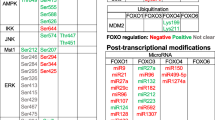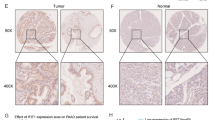Abstract
Background
Trefoil factor family 1 (TFF1) is a member of the TFF-domain peptide family involved in epithelial restitution and cell motility. Recently, we screened Piezo1 as a candidate TFF1-binding protein.
Aim
We aimed to confirm Piezo1 as a novel TFF1 binding protein and to assess the role of this interaction in mediating gastric cancer cell mobility.
Methods
This interaction was confirmed by co-immunoprecipitation and co-localisation of TFF1 and Piezo1 in GES-1 cells. We used stable RNA interference to knockdown Piezo1 protein expression and restored the expression of TFF1 in the gastric cancer cell lines SGC-7901 and BGC-823. Cell motility was evaluated using invasion assay and migration assay in vitro. The expression levels of the integrin subunits β1, β5, α1 as well as the expression of β-catenin and E-cadherin were detected by Western blot.
Results
We demonstrate that TFF1, but not TFF2 or TFF3, bind to and co-localize with Piezo1 in the cytoplasm in vitro. TFF1 interacts with the C-terminal portion of the Piezo1 protein. Wound healing and trans-well assays demonstrated that the restored expression of TFF1 promoted cell mobility in gastric cancer cells, and this effect was attenuated by the knockdown of Piezo1. Western blots demonstrated the decreased expression of integrin β1 in Piezo1-knockdown cells.
Conclusions
Our data demonstrate that Piezo1 is a novel TFF1 binding protein that is important for TFF1-mediated cell migration and suggest that this interaction may be a therapeutic target in the invasion and metastasis of gastric cancer.




Similar content being viewed by others
Abbreviations
- TFF1:
-
Trefoil factor family-1
- COX:
-
Cyclooxygenase
- TXA2-R:
-
Thromboxane A2 receptor
- GC:
-
Gastric cancer
- Y2H:
-
Yeast two-hybrid
- cDNA:
-
Complementary DNA
- siRNA:
-
Short interfering RNA
- co-IP:
-
Co-immunoprecipitation
References
Taupin D, Podolsky DK. Trefoil factors: initiators of mucosal healing. Nat Rev Mol Cell Biol. 2003;4:721–732.
Thim L, May FE. Structure of mammalian trefoil factors and functional insights. Cell Mol Life Sci. 2005;62:2956–2973.
May FEB, Griffin SM, Westley BR. The trefoil factor interacting protein TFIZ1 binds the trefoil protein TFF1 preferentially in normal gastric mucosal cells but the co-expression of these proteins is deregulated in gastric cancer. Int J Biochem Cell Biol. 2009;41:632–640.
Clyne M, Dillon P, Daly S, et al. Helicobacter pylori interacts with the human single-domain trefoil protein TFF1. Proc Natl Acad Sci USA. 2004;101:7409–7414.
Kjellev S. The trefoil factor family—small peptides with multiple functionalities. Cell Mol Life Sci. 2009;66:1350–1369.
Lefebvre O, Chenard MP, Masson R, et al. Gastric mucosa abnormalities and tumorigenesis in mice lacking the pS2 trefoil protein. Science. 1996;274:259–262.
Park WS, Oh RR, Park JY, et al. Somatic mutations of the trefoil factor family 1 gene in gastric cancer. Gastroenterology. 2000;119:691–698.
Rodrigues S, Nguyen QD, Faivre S, et al. Activation of cellular invasion by trefoil peptides and src is mediated by cyclooxygenase- and thromboxane A2 receptor-dependent signaling pathways. FASEB J. 2001;15:1517–1528.
Rodrigues S, Attoub S, Nguyen QD, et al. Selective abrogation of the proinvasive activity of the trefoil peptides pS2 and spasmolytic polypeptide by disruption of the EGF receptor signaling pathways in kidney and colonic cancer cells. Oncogene. 2003;22:4488–4497.
Spruck C, Sun D, Fiegl H, et al. Detection of low molecular weight derivatives of cyclin E1 is a function of cyclin E1 protein levels in breast cancer. Cancer Res. 2006;66:7355–7360.
Miyagishi M, Taira K. U6 promoter-driven siRNAs with four uridine 3′ overhangs efficiently suppress targeted gene expression in mammalian cells. Nat Biotechnol. 2002;20:497–500.
Guleng B, Tateishi K, Ohta M, et al. Blockade of the stromal cell-derived factor-1/CXCR4 axis attenuates in vivo tumor growth by inhibiting angiogenesis in a vascular endothelial growth factor-independent manner. Cancer Res. 2005;65:5864–5871.
Coste B, Xiao B, Santos JS, et al. Piezo proteins are pore-forming subunits of mechanically activated channels. Nature. 2012;483:176–181.
McHugh BJ, Buttery R, Lad Y, Banks S, Haslett C, Sethi T. Integrin activation by Fam38A uses a novel mechanism of R-Ras targeting to the endoplasmic reticulum. J Cell Sci. 2010;123:51–61.
Emami S, Rodrigues S, Rodrigue CM, et al. Trefoil factor family (TFF) peptides and cancer progression. Peptides. 2004;25:885–898.
Liu D, El-Hariry I, Karayiannakis AJ, et al. Phosphorylation of beta-catenin and epidermal growth factor receptor by intestinal trefoil factor. Lab Invest. 1997;77:557–563.
Uchino H, Kataoka H, Itoh H, Hamasuna R, Koono M. Overexpression of intestinal trefoil factor in human colon carcinoma cells reduces cellular growth in vitro and in vivo. Gastroenterology. 2000;118:60–69.
Woo DK, Kim HS, Lee HS, Kang YH, Yang HK, Kim WH. Altered expression and mutation of beta-catenin gene in gastric carcinomas and cell lines. Int J Cancer. 2001;95:108–113.
Brakebusch C, Bouvard D, Stanchi F, Sakai T, Fassler R. Integrins in invasive growth. J Clin Invest. 2002;109:999–1006.
Damsky CH, Ilic D. Integrin signaling: it’s where the action is. Curr Opin Cell Biol. 2002;14:594–602.
Fukuda K, Saikawa Y, Yagi H, Wada N, Takahashi T, Kitagawa Y. Role of integrin alpha1 subunits in gastric cancer patients with peritoneal dissemination. Mol Med Report. 2012;5:336–340.
Hung WY, Huang KH, Wu CW, et al. Mitochondrial dysfunction promotes cell migration via reactive oxygen species-enhanced beta5-integrin expression in human gastric cancer SC-M1 cells. Biochim Biophys Acta. 2012;1820:1102–1110.
Snider JL, Allison C, Bellaire BH, Ferrero RL, Cardelli JA. The beta1 integrin activates JNK independent of CagA, and JNK activation is required for Helicobacter pylori CagA + -induced motility of gastric cancer cells. J Biol Chem. 2008;283:13952–13963.
McHugh BJ, Murdoch A, Haslett C, Sethi T. Loss of the integrin-activating transmembrane protein Fam38A (Piezo1) promotes a switch to a reduced integrin-dependent mode of cell migration. PLoS ONE. 2012;7:e40346.
Hood JD, Cheresh DA. Role of integrins in cell invasion and migration. Nat Rev Cancer. 2002;2:91–100.
Morello V, Cabodi S, Sigismund S, et al. beta1 integrin controls EGFR signaling and tumorigenic properties of lung cancer cells. Oncogene. 2011;30:4087–4096.
Acknowledgments
This study was supported by National Natural Science Foundation of China (No. 81370505, 81370591 & 91229201), Key Projects for Technology Plan of Xiamen (No. 3502Z20100002) and Ministry of Health Foundation for State Key Clinical Department in China.
Conflict of interest
None.
Author information
Authors and Affiliations
Corresponding authors
Additional information
Xiao-Ning Yang and Ya-Pi Lu contributed equally to this work.
Electronic supplementary material
Below is the link to the electronic supplementary material.
10620_2014_3044_MOESM1_ESM.tif
Supplementary Figure. A Two siRNA target sites for Piezo1 were designed and subcloned into pU6 and transfected into 293T cells to screen the silencing efficacy by western blotting. B Western blots depicting the expression of Piezo1 and TFF1 in SGC7901 and BGC-823 of cells overexpressing TFF1 (pU6-F1), TFF1 with a knockdown of Piezo1 (siP-F1), control cells transfected with an empty vector (pU6-HA) and Piezo1-knockdown cells (siP-HA). GAPHD is shown as a loading control. (TIFF 1358 kb)
Rights and permissions
About this article
Cite this article
Yang, XN., Lu, YP., Liu, JJ. et al. Piezo1 Is as a Novel Trefoil Factor Family 1 Binding Protein that Promotes Gastric Cancer Cell Mobility In Vitro. Dig Dis Sci 59, 1428–1435 (2014). https://doi.org/10.1007/s10620-014-3044-3
Received:
Accepted:
Published:
Issue Date:
DOI: https://doi.org/10.1007/s10620-014-3044-3




